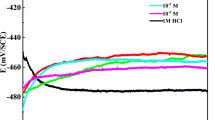Abstract
A correlation between specific adsorption and corrosion inhibition was made on the basis of calculations of the degree of coverage at zero charge on the electrode and corrosion rates. 1-butylpyridinium bromide (BPB) was choosen as a model compound for these studies. The electrical double-layer parameters were determined at constant charge on a mercury electrode, from values of the interfacial capacity and surface tension obtained experimentally from aqueous solutions of BPB at 25° C. The characteristics of the salt as a corrosion inhibitor were studied through Tafel plots and weight-loss measurements using mild steel plates immersed in H2SO4 solutions. Analysis of the results lead to the conclusion that the salt adsorbs intensely on the metal surface, forming a complete monolayer of BP+ ions in 0.1 mol dm−3 solutions and multilayers for higher concentrations. The results of this work indicate that for high coverages there is a good correlation between the amount of BP+ specifically adsorbed on mercury and the inhibition of the corrosion process on mild steel. That type of compound acts mainly as an anodic inhibitor in acid media by the formation of protective layers on the metal surface.
Similar content being viewed by others
References
J. B. Hayter and R. J. Hunter,J. Electroanal. Chem. 37 (1972) 71.
J. B. Hayter and R. J. Hunter,J. Electroanal. Chem. 37 (1972) 81.
T. P. Hoar and R. D. Holliday,J. Appl. Chem. 3 (1953) 502.
J. M. West,J. Appl. Chem. 10 (1960) 250.
R. J. Meakins,Australasian Corrosion Engineering 11 (1967) 5.
K. Chandrasekhara Pillar and R. Narayan,J. Electrochem. Soc. 125 (1978) 1393.
E. R. González,J. Electroanal. Chem. 90 (1978) 431.
A. W. M. Verkroost, M. Sluyters-Rehbach and J. H. Sluyters,J. Electroanal. Chem. 24 (1970) 1.
J. Lawrence, R. Parsons and R. Payne,J. Electroanal. Chem. 16 (1968) 193.
M. A. V. Devanathan and M. J. Fernando,Trans. Faraday Soc. 58 (1962) 368.
P. Delahay, ‘Double Layer and Electrode Kinetics’, Wiley-Interscience, New York (1965) p. 54.
J. V. Leyendekkers and R. J. Hunter,J. Electroanal. Chem. 81 (1977) 123.
Author information
Authors and Affiliations
Rights and permissions
About this article
Cite this article
Avaca, L.A., González, E.R. & Filho, A.R. Correlation between specific adsorption and corrosion inhibition. Adsorption of 1-butylpyridinium bromide. J Appl Electrochem 12, 405–410 (1982). https://doi.org/10.1007/BF00610481
Received:
Issue Date:
DOI: https://doi.org/10.1007/BF00610481




